Yeast Artificial Chromosome Building Service
Yeast artificial chromosome (YAC) is a shuttle cloning vector that structurally mimics the linear DNA molecules of the yeast chromosome and can clone 400 kb DNA fragments. It contains the plasmid ori of the first recipient E. coli and the functional elements of the second recipient yeast chromosome, including the mitotic site, replication initiation site, and telomere, which are essential for plasmid cloning vectors. Lifeasible can provide you with YAC vector construction services to help you construct large fragment DNA libraries, especially genomic libraries of higher eukaryotic organisms.

- Isolation of large pieces of DNA. Our first step in creating a YAC is to isolate a large piece of DNA from your organism of interest. This DNA can be obtained from genomic DNA or cDNA libraries.
- Vector preparation. YAC vectors are circular DNA fragments modified to carry the target DNA. The vector usually includes a yeast replication start, a selection marker, and telomeric sequences to stabilize the ends of the chromosomes.
- DNA and vector digestion. We subject your DNA of interest and the YAC vector to restriction digest enzymes. The restriction enzyme cuts the DNA and vector at specific sites, creating sticky ends that are complementary to each other.
- DNA and vector ligation. We ligate digested DNA to the vector using DNA ligase to connect the complementary sticky ends of the DNA and the vector. We can introduce exogenous DNA into the YAC vector using various methods, including electroporation and transformation.
- Transformation of yeast cells. Transformation is the process of introducing DNA into a cell, and we introduce the ligation mixture into yeast cells through this process. Yeast cells integrate the vector into their genome, replicating the YAC like their own chromosomes.
- Selection of transformed cells. After transformation, we inoculated the yeast cells with a selective medium that only allowed the growth of cells containing the YAC vector. Yeast cells containing YAC can be identified using a genetic marker expressed by the yeast cells containing YAC. We can select YAC-containing yeast cells using various methods, including antibiotic resistance and nutritional markers.
- YAC validation. We will also screen your transformed cells to verify the presence of YAC. We can do this by PCR analysis, Southern blotting, or other methods.
Advantages
- Large capacity. The YAC libraries we offer you are typically loaded with DNA fragments up to 200-500 kb in size, some up to 1 Mb or more, and even up to 2 Mb. Large DNA sequence inserts are more likely to contain complete functional genes, allowing for larger step distances in chromosome steps at a time, as well as the ability to reduce the number of clones required for a complete genomic library.
- Good stability. The yeast cells used in YAC are more tolerant of unstable, repetitive, and extreme DNA than E. coli.
- A powerful tool for functional genomic research. The YAC vectors we offer you are a handy tool in functional gene and genome research. Since most of the genes in higher eukaryotes are multi-exon structures and have long introns, large genomic fragments can be transferred into animals or animal cell lines for functional studies with YAC vectors.
Lifeasible creates YACs by inserting large segments of DNA into a ring vector, which is then introduced into yeast cells and integrated into yeast chromosomes. This can provide you with a powerful tool for genetic research and the creation of artificial chromosomes for gene therapy. Please feel free to contact our staff for your program.
For research or industrial raw materials, not for personal medical use!
